Menu
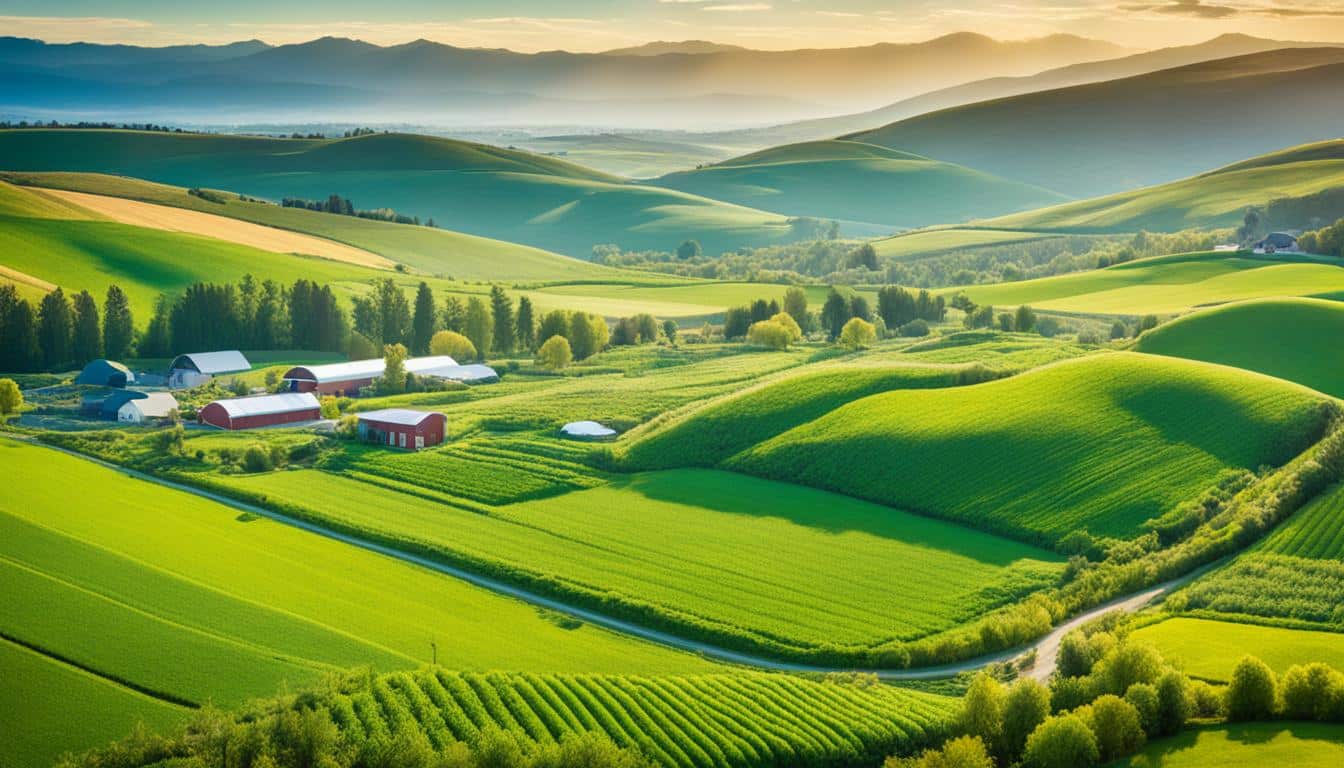
Denmark reached a big milestone in 2021. Their market share for organic food and drinks hit 13.0%, the best worldwide. This shows how Denmark leads in the organic farming field. The journey started in the 1930s with government help and smart rules. As people have learned more about how regular farming affects nature, Denmark’s government has stepped up. They now help organic farming with ways to both make and sell the products.
Compared to other European countries, Denmark’s way really stands out. Each country in the European Union does farming in its own way. But, Denmark’s success comes from bringing together both organic and regular farmers. This makes sure everyone’s interests are considered. Thanks to this, Denmark has become a leader in doing farming in a way that protects our planet. At the same time, it helps farmers make a good living.
Denmark has a unique story in adopting organic farming. It’s known for its innovation, strong commitment, and smart policies. The government there has been leading, giving a big push for organic farming to grow.
Organic farming started in Denmark back in the early 1900s. It was shaped by *Rudolf Steiner’s organic principles*. Steiner focused on eco-friendly farming, highlighting the importance of healthy soil and diverse wildlife.
Since those early days, Denmark has seen a huge jump in organics. In 1997, only 2.5% of food sold was organic. By 2019, this had grown to 12.1%. Denmark’s growth outpaced other champions like Switzerland and Austria, making it a top organic producer worldwide.
The success of organic farming in Denmark is thanks to strong government policies. The *EU’s organic farming subsidies* in the 1990s were a key boost. They allowed countries like Denmark to create their own organic farming support plans.
The turning point came with the Organic Action Plan 2020 in Denmark. It aimed for 60% of food in public places to be organic. There was also a plan to help farms switch to organics and assist with providing organic foods in public cafeterias.
The Danish government really put their support behind organics. They’ve invested about 6 million euros in an Organic Agriculture Fund. This fund covers six key areas to sustain the industry’s growth.
Denmark has set a high bar to reach by 2030. They aim to double the space used for organic farming, double organic food sales, and double their organic exports. This forward-thinking approach has increased Denmark’s organic food market share to 13.0% in 2021. Plus, 93% of Danes occasionally buy organic, and 55% do so every week. These figures show just how much people in Denmark value and support organic farming.
Denmark has been a key player in the organic food industry since the beginning. It led the way, joining countries like Austria, Switzerland, and Sweden. The interest in organic methods wasn’t just driven by the market. It was deeply connected to the country’s political view on the environment. This focus on green issues helped start the early Danish organic movement.
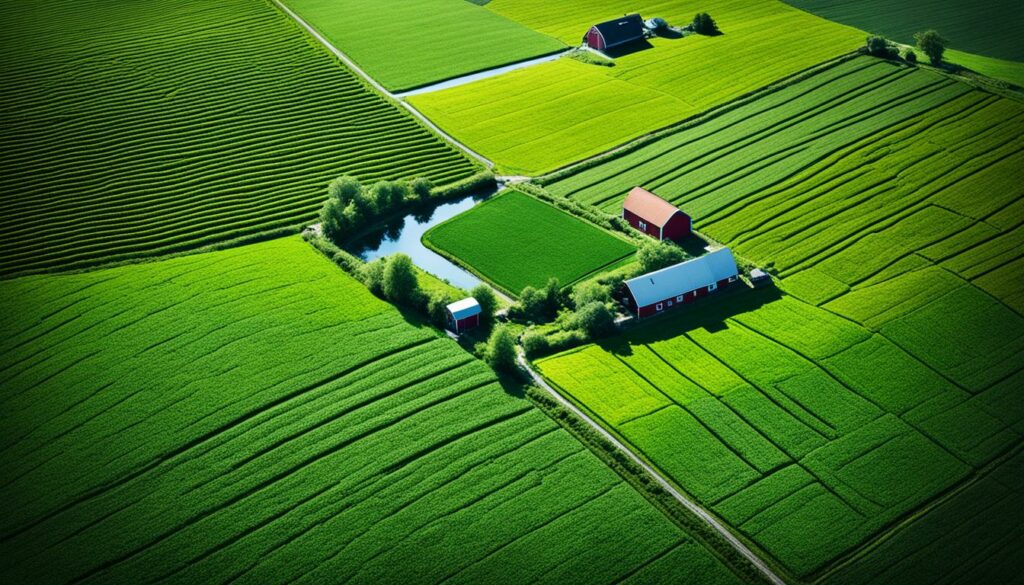
During the 1980s and 1990s, Denmark realised the harm from standard farming practices. Big changes came as the government looked into the environmental impact analysis. They wanted to understand problems like agricultural pollution. This understanding birthed in-depth organic farming rules centered on being green.
The start of Danish organic advisory services was crucial. They turned ideas into actions for farmers. These services helped farmers switch to organic ways, showing them how to meet the new rules. This helped Danish organic farming be praised for its boost to animal homes, lower pollution, and care for animals.
Denmark’s organic farming story mixes early political interest, detailed environment studies, and strong support systems. The country tackled agricultural pollution by focusing on organic growth. It also sparked a growing organic industry through dedication and smart moves.
| Year | Key Milestones |
|---|---|
| 1997 | 2.5% of food purchases were organic |
| 2019 | 12.1% of food sales were organic |
| 2003-2019 | Organic food exports rose from 2.3 million DKK to 3 billion DKK |
Denmark’s way of handling organics sets the bar high in new food making. It’s a big reason their organic scene is doing so well. They help both the people making organic stuff and the people who want to buy it. This way, they make sure everyone involved in making food looks after the environment.
Denmark’s government supports farmers to go organic with special help like money and advice. They also do things to get more people to choose organic food. This mix has made the country’s organic spending per person the highest worldwide. It shows their plan really works.
Denmark’s smart way is joining the groups that like organic or normal farming. This teamwork has made farming better for everyone. They’ve made big improvements, like having nearly all organic meals in Copenhagen by 2015. But, they didn’t have to put up the prices of food to do it.
Below is a comparative data table illustrating the market share of organic food in various countries as of 2019:
| Country | Market Share of Organic Food (%) |
|---|---|
| Denmark | 12.1 |
| Switzerland | 10.4 |
| Austria | 9.3 |
| Sweden | 9.0 |
Denmark is high-flying thanks to its great plans and support for new food ways. They blend organic and usual farming well. This makes Denmark a top model for the world in how it farms and cares for nature.
Denmark has done a great job in encouraging green farming. They use many tools to make farming eco-friendly. This has led to big success in organic farming.
The Danish way of doing things is smart. It involves thinking up new uses for tools and keeping a close eye on how well everything works.
Denmark does well in making its agriculture green because it uses the right tools. These tools include help with money, advice, and making the market friendly for organic products.
The money help is given to change regular farms into organic ones and to make existing organic farms better. The government also provides experts to help farmers. This is to make sure farmers know what they’re doing and have what they need.
Thanks to these tools, organic farming in Denmark is booming. This has helped the environment in good ways, like more types of plants and animals, happier animals, and cleaner water.
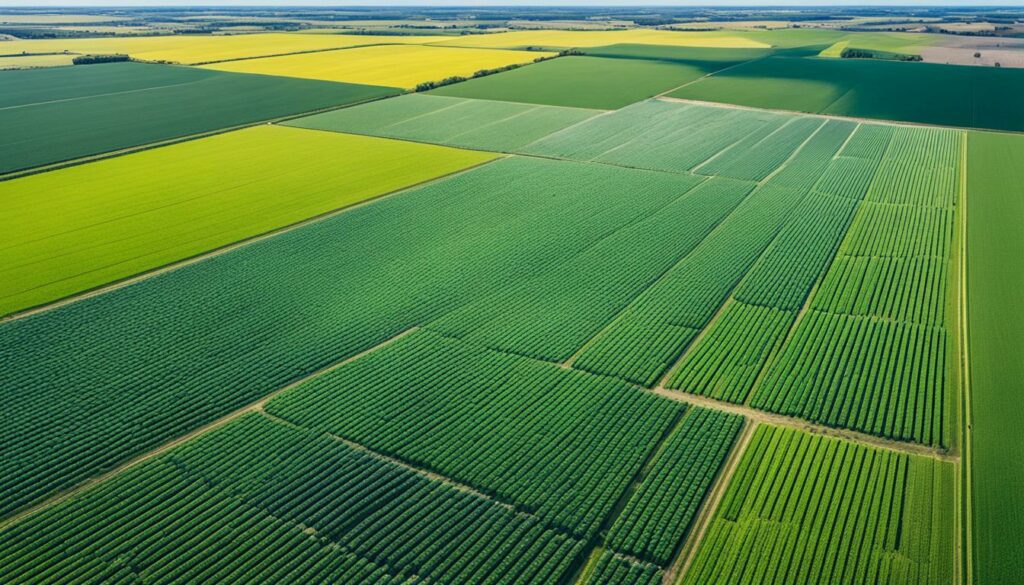
Danish actions in organic farming have shown big results. For example, more people are buying organic food. In 2019, 12.1% of all food sales were organic in Denmark.
This shows that people in Denmark really like organic food. The support from the government has helped. More people choosing organic food means good growth and better care for the environment.
Also, Denmark is now exporting more organic stuff. The value has gone up a lot. This shows that not only Danish people like their organic food, but many others around the world do too. It’s a sign that Denmark is doing well in making its agriculture sustainable.
| Country | Organic Food Sales (%) |
|---|---|
| Denmark | 12.1 |
| Switzerland | 10.4 |
| Austria | 9.3 |
| Sweden | 9.0 |
| Finland | 2.6 |
| Norway | 1.7 |
Denmark’s organic sector has faced many hurdles, especially in growing the market and overcoming issues in agricultural sustainability. Though 12.1% of food was organic in 2019, the sector is still working on managing risks and increasing its size.
Keeping the market growing is a big issue for Danish organic farmers. The government helped a lot by boosting exports, which went from 2.3 million kroner to 3 billion kroner from 2003 to 2019. But, to keep up, they must deal with problems like losing biodiversity and using too many pesticides.
Many have helped navigate these issues, including the government, farmers, and advice services. The aim is not only to sell more organic food but to eat more of it. This has helped Denmark do well in being eco-friendly, like keeping water cleaner and looking after animals better.
Here is how Denmark compares to other countries in selling organic food:
| Country | Percentage of Organic Food Sales |
|---|---|
| Denmark | 12.1% |
| Switzerland | 10.4% |
| Austria | 9.3% |
| Sweden | 9.0% |
| Finland | 2.6% |
| Norway | 1.7% |
Organic food consumption grows thanks to private buyers and government-led efforts. But, danger from pesticides still worries many. For example, Denmark sold 9075 tons of pesticides in 2014, making up 0.5% of all sold in the EU.
While Danish organic farming is making headway, there are still challenges in growing the market and staying green. Working together has helped tackle these issues. It keeps Denmark moving forward in the organic market.
Creating the right policies for organic farming has been key to Denmark’s achievements. They’ve aimed for a balanced way of growing their market and making new farms organic. This approach helps the organic sector grow without hurting the environment.
Denmark looks carefully at what people want to buy, and it has paid off. They’ve managed to grab both local and global chances, making their organic food sector boom.
Since 1987, Denmark has worked hard to grow organic farming. They’ve been smart about this, fitting their policies with what the market needs. By doing this well, Denmark has become a top player in the organic food world, with organic sales making up 12.1% by 2019.
Denmark always listens to different views when making policies. To grow organic farming and its market together, finding a good balance is crucial. Danish leaders have done this by offering good support and helpful incentives.
This careful policy work has really paid off. They have seen a big jump in how much Danish organic produce they export. From only 2.3 million kroner in sales in 2003, they reached 3 billion kroner in 2019.
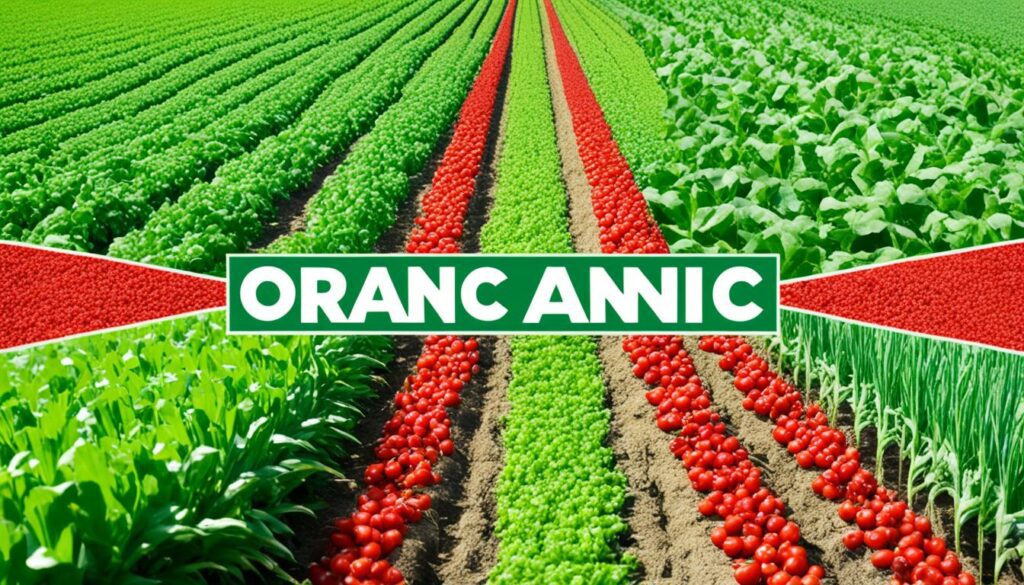
Being flexible is crucial in Denmark’s organic farming policies. They always adapt to what consumers want and how markets change. This approach has led to a strong strategy for selling organic products abroad.
Denmark’s success in foreign markets shows their policy choices are working. Their strong support for organic farming gets backing from many groups and officials. This support helps Danish plans work smoothly.
Denmark focuses on making sure their organic food fits the global market. By making smart changes, they keep their edge in the organic world. Their approach meets the needs of both local and worldwide customers.
| Country | Organic Food Sales (% of Total Food Sales, 2019) |
|---|---|
| Denmark | 12.1% |
| Switzerland | 10.4% |
| Austria | 9.3% |
| Sweden | 9.0% |
| Finland | 2.6% (2016) |
| Norway | 1.7% (2016) |
Denmark’s organic farming sector is a strong example of a lasting agricultural plan. In 2019, Denmark dominated world organic food sales, with 12.1% being organic. This was much higher than Sweden’s 9.0%. And it was well above Finland and Norway’s numbers from 2016, which were 2.6% and 1.7%, respectively. The country’s dedication to organic farming since 2003 is behind this success. Danish organic food exports surged from 2.3 million kroner to 3 billion kroner by 2019.
The success can be seen in the broad national support these policies enjoy. There isn’t universal agreement on how to gauge the success of an organic policy. But, measuring the amount of land used for organic farming is widely used.
Denmark’s model combines actions that help farmers and policies that increase demand. This full-picture approach is good for the environment, including boosting biodiversity and cutting pollution. Therefore, the organic policy within Denmark’s strategy supports a thriving, eco-friendly farming sector.
In addition to this success, Danish organic pork and vegetable sales are rising. At the same time, dairy production has not seen much change since the 90s. Research will focus on how these parts of the industry are growing. It will look at the role of supply chains and the economy. Such efforts are key to keeping Denmark’s organic farming sector strong in changing market conditions.
Organic farming in Denmark has shown big environmental wins, proving its drive for green agriculture. By 2019, a large 12.1% of all food sold in Denmark was organic. This beat other European countries like Switzerland, Austria, and Sweden.
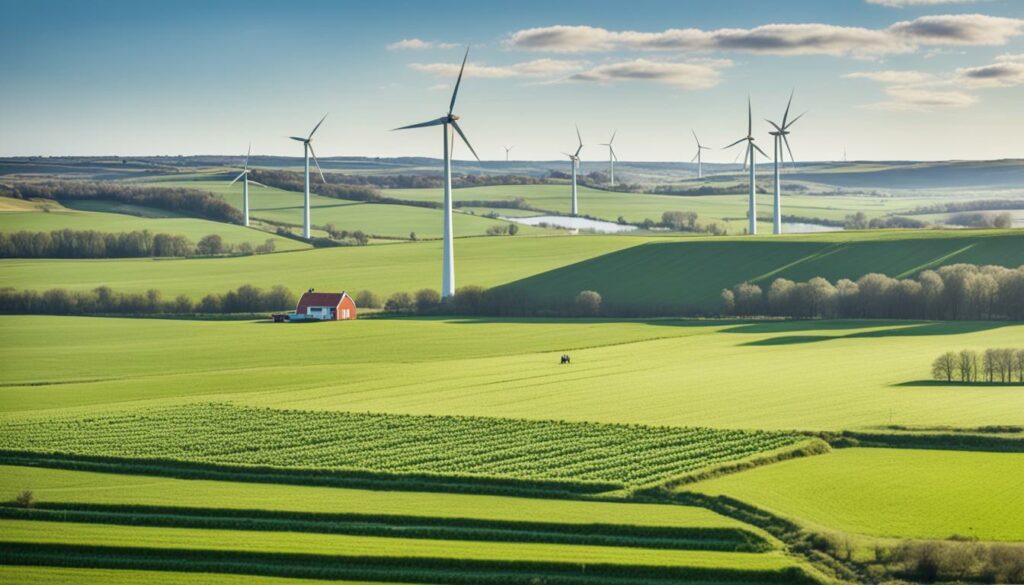
Organic farming boosts the life around it, helping plant and animal diversity by about 30% in fields and nearby spaces. This means more wild plants, pollinating insects, and a whole variety of animals. Thanks to using fewer pesticides, Denmark has kept its nature healthier. In 2014, the country used way less pesticides than others in the EU-28. Plus, organic food in Europe has less pesticide on it than regular food. This shows how organic farming really helps the environment.
Organic farming also fights climate change by reducing greenhouse gases. Research shows organic food has a lower climate impact and uses less energy. It’s also better for the soil’s health. These points are key in Denmark’s green plan.
A review in 2020 of many studies didn’t find organic food and regular food to differ much in climate impact by weight. Yet, organic farming does better when looking at the land it uses. This supports Denmark’s aim to lead in eco-friendly farming.
To sum up, in Denmark, choosing organic farming means supporting a healthy, diverse environment and less global warming. The country’s smart policies and use of the latest research keep pushing for better eco results.
Denmark leads the world in organic food and drinks, with a 13.0% share in 2021. This shows big growth in the Danish organic market. It’s mainly because 93% of the people in Denmark sometimes buy organic. And, nearly 85% of these sales happen in big stores.
In Denmark, knowing what customers like is key. In 2020, 55% of Danes bought organic food every week. This shows Danes really prefer organic food. Plus, the government is trying to get more organic crops grown. Even though there was a small slow-down, Denmark is still number one in the world for organic food.
Supermarket sales are boosting the organic market in Denmark. The country set a goal in its first Organic Action Plan to have 60% organic food in public places. This included schools and nursing homes. In 2020, Denmark set even higher goals. They aim to have more organic farms and more sales by 2030. This move has made supermarkets important for selling organic food, meeting what customers want.
| Year | Percentage of Organic Food Sales | Leading Countries |
|---|---|---|
| 1997 | 2.5% | Denmark |
| 2019 | 12.1% | Denmark |
| 2019 | 10.4% | Switzerland |
| 2019 | 9.3% | Austria |
Supermarkets and food services are making organic food more available. They also shape what people think about organic food. Making organic food easy to buy and afford has helped Denmark stay on top in the global organic market.
Denmark leads in using new agriculture tech for green farming. It’s an example in the world for making food in an eco-friendly way. Since the late 1990s, Danes have been big on buying organic food. In 2019, 12.1% of what they ate was organic. This was more than what people in Switzerland and Austria bought. The high percentage shows how much Denmark cares about being green in farming.
In 1987, Denmark took a big step with the Act on Organic Farming. It showed the government was really into helping organic farming grow. The help from the government meant more organic food left Denmark for other countries. The amount Denmark made from these exports went up big time. From 2003 to 2019, it went from 2.3 million Danish kroner to 3 billion.
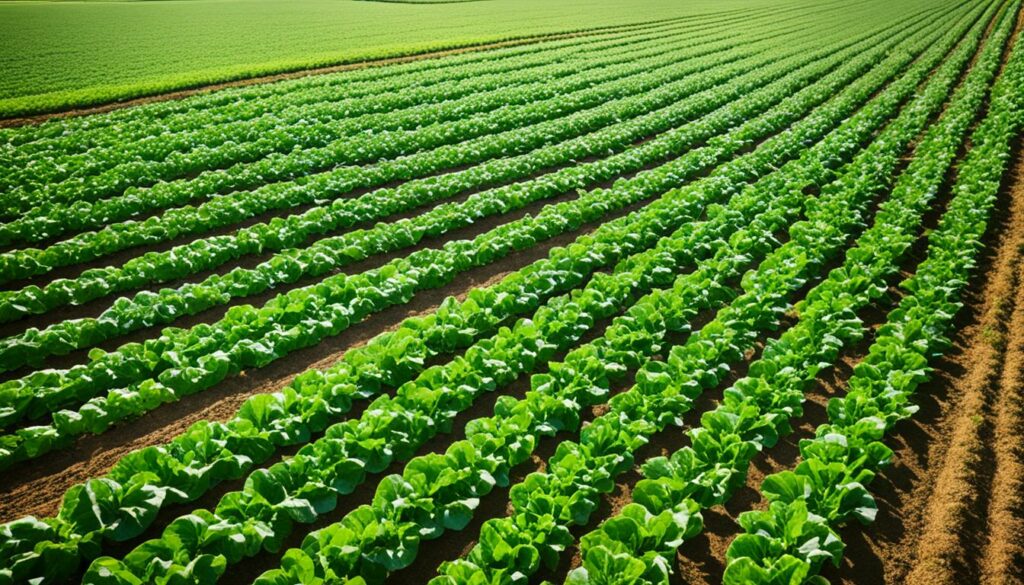
Denmark knows doing farming that’s good for the planet is super important. They use the newest tools and tricks to work better without hurting the environment. They mix new technology with old, organic ways. This mix makes sure farming stays good for the Earth.
Denmark’s leaders and farmers work together a lot to make green farming possible. The country’s good at weaving green ways into their farming over time. Both at home and abroad, more and more people buy organic food. This shows Denmark’s smart approach is popular and spreading.
Denmark’s success teaches us a big lesson. Using new farming tech in a way that’s good for the environment really works. It makes food better and the world healthier. This is good news for everyone who eats and the planet we live on.
Denmark is at the forefront of organic farming, thanks to its strict organic certification process. This process focuses on tight organic farming standards. These standards are checked thoroughly.
In Denmark, getting organic certification is detailed and strict, following national and EU laws. The Danish Agricultural Agency makes sure that farms and their products match these rules. This includes how they manage the land, treat animals, and bans on synthetic chemicals.
One of the main reasons Denmark’s organic sector does so well is consumer confidence in organic labels. The Ø-mark, owned by the state, is a sign of trust. It certifies that products meet high standards. This label makes things clear to buyers and grows trust. As a result, organic food sales were 12.1% of all food sales in 2019. Also, Danish organic food exports rose from 2.3 million Danish kroner in 2003 to 3 billion in 2019.
Denmark’s success in organic farming comes from NGOs working with key groups closely. These include the Danish Organic Association and the Danish Agriculture & Food Council. They push for sustainable farming and for consumers to know more.
The Danish Organic Action Plan stands out, backed by over 200 stakeholders. Their input made sure the plan was thorough and supported by many. This plan won the Future Policy Silver Award in 2018, showing a team effort in policy making.
Thanks to NGO work in Denmark, there have been big wins. For example, Copenhagen made 90 percent of its public kitchen food organic by 2015. Denmark also puts EUR 3.3 million a year into making sure people know more about organic food. This shows how everyone working together can lead to policy success and people trusting what they eat.

Denmark doesn’t just focus on growing more organic food. It also backs ways to farm that are good for the Earth long term. This approach, with help from farmers, policymakers, and NGOs, aims to keep making organic farming better.
As a result, Denmark is a top player in the organic market, all thanks to NGO work and cooperation. Their joint achievements highlight how working together can boost sustainable farming practices.
Denmark is a top player in the organic farming scene. It shows how steady policies and strong political backing can boost sustainable farming. In 2021, the Danish market accounted for 13.0% of all organic food and drink sales worldwide. Nearly all Danes, 93%, buy organic now and then. 55% choose organic food every week.
Most of these goods, about 85%, are sold in supermarkets. This fact highlights the huge part supermarkets play in the organic food market.
Denmark has been steadily leading in organic farming since the 1990s. Sales keep going up. Even though some items, like organic chicken, can be much pricier than regular ones, people still trust and buy them. Luckily, this price gap isn’t as high for other basics like carrots, oatmeal, potatoes, and milk.
Danish organic success owes a lot to political support. Goals set by the government pushed for more organic farmland and demanded that 60% of food in public places be organic. The plan is to double organic farming areas, sales, and export by 2030. Recent funding of €6 million into the Organic Agriculture Fund shows political dedication to the sector’s growth.
Strict rules and thorough oversight continue to develop the organic market. The government is working hard to overcome challenges in the industry such as market growth and sustainability. This proactive stand helps keep Denmark at the forefront of organic agriculture. It secures a bright future for the organic farming sector in the country.
| Aspect | Statistics |
|---|---|
| Market Share in Organic Food | 13.0% (2021) |
| Frequency of Organic Purchases | 55% weekly (2020) |
| Channels of Organic Sales | 85% supermarkets, 10% food service, 5% food markets |
| Target for 2030 | Double organic land, sales, and exports |
| Funding for Organic Agriculture | €6 million |
| Organic Land Share in Denmark | 11.3% (2020) |
Denmark’s path to being an organic farming leader has been impressive. Since the late 1990s, it has been on top in organic food sales. In 2019, 12.1% of all food sold was organic. This shows Denmark’s strong focus on eco-friendly farming. The country’s use of organic food has been growing since 1997.
The drive isn’t just from farmers themselves. It comes from big government efforts and wide support. This includes politicians and those working in the industry.
The Danish export industry for organic products has grown a lot. From 2.3 million Danish kroner in 2003 to 3 billion kroner in 2019. This shows a big world demand for Denmark’s top-notch organic goods.
The Act on Organic Farming started things in 1987. Since then, more policies have helped organic production. This led to selling more and using less harmful pesticides.
Organic farming makes a big difference for our planet. It boosts biodiversity by 30% compared to other ways. Danish farms with lots of legumes and grass are a great spot for different species.
This commitment to green ways makes Denmark special. Even nearby countries like Finland and Norway don’t use organic food as much. Denmark’s mix of smart rules, global selling, and earth-friendly farming is a great example for the future.
“Denmark stands out because of its full-circle approach to organic farming. It combines supply and demand measures and promotes agreement within the sector. The country has supported agricultural development and incomes since the 1930s. It has shifted significantly towards organic farming more recently.”
“The Danish government has played a key role, making organic farming a national priority. It provides big support through subsidies and advice. It has also created a state-owned organic label to ensure trust with consumers.”
“Organic farming in Denmark emerged from Rudolf Steiner’s ideas. His principles were later adopted as part of national policies to tackle environmental issues.”
“The early focus on environmental problems by politicians was crucial. Organisations for organic farming were then set up. Denmark developed strong policies, addressing pollution in agriculture.”
“Denmark’s model incorporates both supply and demand issues. It involves both organic and conventional farming interests in making policies. It also uses advanced agricultural methods to increase market share.”
“The effects of these policies have been clear. Eating more organic food and more sustainable agriculture are two big wins. There has also been a big jump in exports of organic products.”
“There have been issues with developing markets and managing risks. Sustainability in agriculture has also been a challenge. Many groups have worked on these problems, improving the industry’s long-term health.”
“Denmark has managed well by meeting market demands and enjoying export chances. The country has a deep, well-thought-out organic farming strategy. It focuses on the needs of both the market and producers.”
“Sticking to strong policies and long-term plans has been vital for Denmark’s organic growth. It ensures the ongoing success of the country’s organics sector.”
“Organic farming in Denmark has lowered pollution, boosted biodiversity, and cut down greenhouse gases. It shows how turning to sustainable farming practices can help the environment.”
“Consumer choices, shaped by the availability and cost of organic products, have played a big part in market growth. This has made Denmark’s organic sector bloom.”
“Denmark uses cutting-edge agricultural tech for sustainable and efficient food production. This commitment to innovation leads to better ecological farming methods.”
“To get certified, farms must meet strict standards. The state’s organic label verifies the quality of the produce. This builds trust with buyers about what they’re getting.”
“NGOs contribute a lot by helping to set up and support the sector’s policies. They work with others to push for sustainable farming.”
“Denmark leads in organics thanks to steady policies, strong political backing, and a dedication to sustainable farming at a global level. It stands out as a model in sustainable agriculture.”